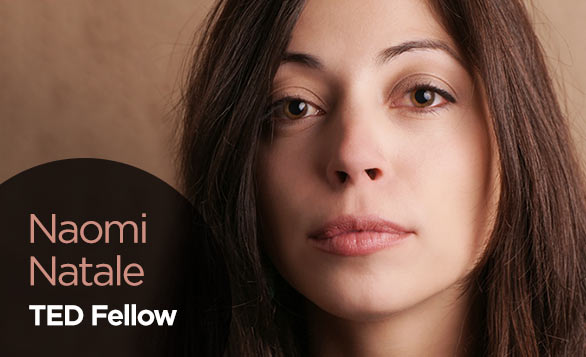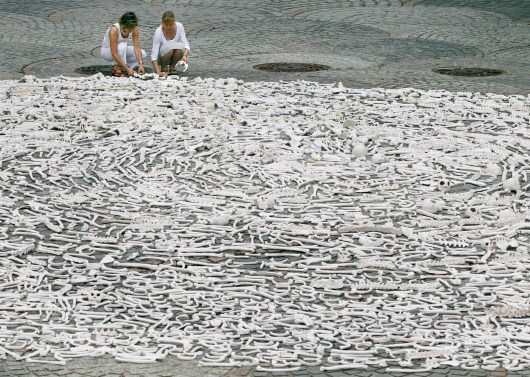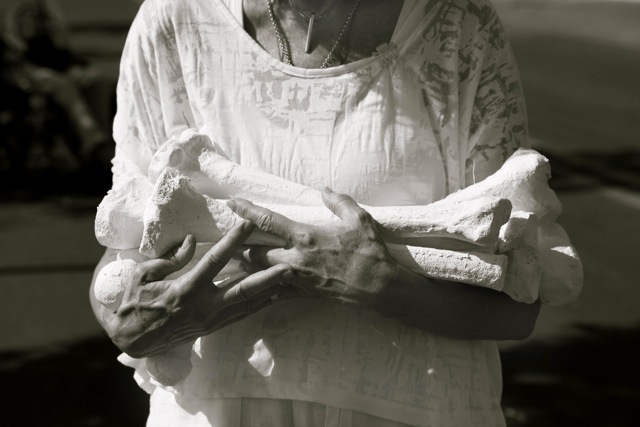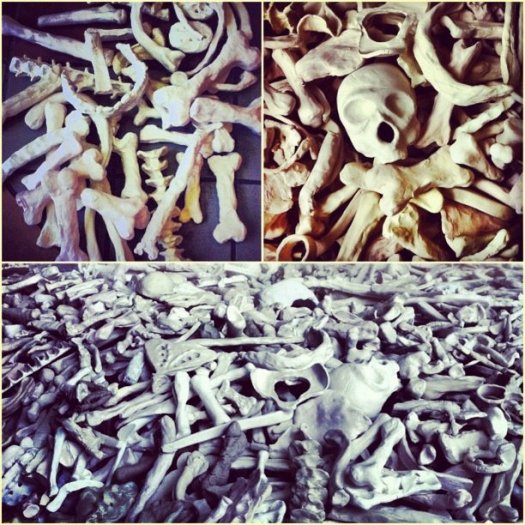For four years, artist Naomi Natale’s social art practice, the One Million Bones project, has used education, hands-on artmaking and public art installation to raise awareness of ongoing genocide and mass atrocities. On June 8, Naomi and the One Million Bones team will be joined by thousands of volunteers to lay down the one million human “bones,” which participants have made by hand, on the National Mall in Washington, DC — creating a striking visual representation of conflicts we cannot continue to ignore.
Here, we chat with Natale about where the idea for this fascinating demonstration came from.
You’ve been working on the One Million Bones Project for a long time, and it has grown from an idea into massive, global art project. How did you get here?
My background is in art and photography, and I’m especially interested in the intersection of art and activism — particularly the ways art can be used to bring issues that are physically far away close to home on an emotional level. I am deeply committed to the issue of genocide and mass atrocities, and One Million Bones is my way of addressing that.
One Million Bones called for individuals all over the world to create an artistic representation of a human bone, which would then be installed on the National Mall as a visible petition and symbolic mass grave. The installation will be happening June 8 through the 10, 2013.
There have been years of activity leading up to this moment. Tell us about the grass-roots education effort involved.
One of the biggest elements of the project has been the educational component, because so many young people and adults simply don’t know what genocide is — let alone that it is happening today. My concern is, “How will we ever know or look for solutions to an issue if we don’t know what it is and that it is happening?”
We designed curriculum from preschool all the way up to high school so that educators can bring the material into their classrooms in an age-appropriate manner. At the younger age levels, we talk about issues like values, ethics and respect. We talk about virtues and how our bones are like our virtues: they make us who we are though we can’t see them.
For older age groups, we talk directly about genocide and how we can take responsibility as consumers and voters — that our voices matter. The bones they make becomes a symbol of our voices. We then direct students to other organizations that are working on these issues on a deeper level in hopes that this sparks an interest in future activism.
This is a really difficult issue to bring into a classroom. We’ve heard this time and time again, with all the schools that we’ve been working in. But the fact that there’s an activity at the end really opens a space where students can learn about the issues, process them, and then put the intention for change into a direct action. The action piece is really important with an issue this difficult, because otherwise people can be paralyzed by that information, feel completely overwhelmed and want to turn away.
Through the project, thousands of students were able to learn about these issues and connect to their peers abroad. One Million Bones had the amazing opportunity to partner with Students Rebuild to launch a challenge in which each bone made generated a $1 donation, up to $500,000, from the Bezos Family Foundation towards CARE’s work on the ground in Somalia and the Democratic Republic of the Congo.
What is the project’s reach?
We have had over 100,000 participants in schools in all 50 states and 30 countries. It’s been a completely grassroots effort. We laid our first 50,000 bones down in New Mexico in August of 2010. That was a critical moment for us, because it was the first time we could ever see the bones laid out, and we were able to capture a lot of reflections of how people responded. As a result of that event, we launched The Road to Washington ten months later. Thirty-five installations were laid out in 35 state capitals, all on the same day, all community-driven and organized. It was a way for volunteers who were really moved and stirred by the project to galvanize their own communities to lay down bones.
We laid 50,000 bones down in Congo Square in New Orleans in April 2012 as well. In that city, we drew a natural connection between genocide and mass atrocities and the local violence experienced there — a lot of the discussions from the students drew from their personal experience. When they learned about the violence on the scale it is in Sudan and Congo, I think there was this very deep connection and empathy. Students in New Orleans continued to make thousands of bones and have done installations and educational programming since then, often seeing the bones as a way to find their individual voices. It can really be an empowering experience to realize you can do something, can contribute to a larger cause.
Is there always an exhibit of some kind when teachers use the curriculum?
Not always. Sometimes students just make bones and send them in. Sometimes the school or an arts center will host an installation. And sometimes an individual champions the project and decides they’re going to put an installation somewhere public and get a lot of other people involved. We help them from our end virtually, and do what we can to support that process.
In September 2012, with our partners Students Rebuild, we were able to bring on 40 state coordinators, each brining the project into their local communities. Our Colorado state coordinator, Marianne Beard, got over 60 schools in Colorado to work on the project and to make bones. And they produced an installation. That’s just one example of how the project has grown.
How did you become interested in genocide as a topic for art and activism?
The journey began with a book I read in 2003: We Wish to Inform You That Tomorrow We Will Be Killed With Our Families by Philip Gourevitch, which was about the Rwandan genocide. I didn’t learn about the Rwandan genocide until long after it happened and, when I did, I couldn’t believe that I had never heard of it.
It’s hard to wrap your head around how 800,000 people were killed in 90 days predominantly by machetes. You think about the intimacy of killing somebody through a method that takes a lot of power and human energy. The international community absolutely knew what was happening, and we didn’t do anything. There were things that we could have done that wouldn’t have even required us to go in, and we failed to do even that. But it was reading about what happened in Rwanda, plus knowing there was genocide happening in Sudan as well as a conflict ongoing in Congo for years made me want to make Philip’s words come to life and bring it into my part of the world so that others could see it.
The One Million Bones project focuses on Sudan, South Sudan, the Democratic Republic of Congo, Burma and Somalia. These conflicts have been going on for such a long time. Little attention has been paid to them. Next to no action has been taken.
It was 10 years ago last month that the government of Sudan began a genocidal campaign against its civilians in Darfur. Over 300,000 people have died, and over two-and-a-half million people are displaced. It’s pretty inconceivable that President Omar al-Bashir has been indicted by the International Criminal Court with crimes of genocide, crimes against humanity, and yet his regime still stands. In 2004, for the first time ever, the US government recognized a genocide in Sudan while it was happening, and we still failed to take any effective action to intervene.
I think that set an incredibly dangerous precedent because before, we wouldn’t call it genocide and we didn’t take action. But to actually call it a genocide and not take action — I don’t know how we can carry on and say “never again.” When we talk to students about this, it becomes something they want to learn more about, and they want to be more active and aware. So it’s so important to be able to have an opportunity to connect with our youth about these issues, as well as everyone else.
What are the bones made of?
Some are made out of clay. Some are made out of plaster gauze, which is really beautiful to do because it’s like bandaging bones. Some of them are made out of wood. Some of them are glass, metal, paper, and tape — all different materials.
I have to say, when they’re all together, when they’re all laid out, they’re quite striking and really, really beautiful. The main parameter is we ask that they are created in neutral colors. Some people have inscribed their names or prayers or thoughts on their bones as well.
And why a bone?
The bone was chosen as a symbol to attest to the gravity of these issues. But more significantly, it was chosen as a symbol and as a reminder that we belong to each other and that we’re responsible to one another. And that’s important: we’ve gotten a lot of pushback because it’s ultimately pretty out there to have kids making bones to address such an intense issue. But when we were able to explain the project to educators, walk them through it, and talk them through how these bones are ultimately about why we should take care of each other, they were able to embrace it. It’s very provocative, having a lot of children ultimately creating a mass grave on the National Mall. But it sends a message that’s much higher than that.
Are the bones in Washington DC all those that have been created through the program?
Yes, and they’ve been stored in hubs around the country. A lot of them were sent to our base in Albuquerque, New Mexico. Now for the last haul, they’re sending them to DC.
What will happen in DC?
On June 8, we will lay all the bones out on the National Mall, an action performed as a ceremony, starting at 3rd Street, which is the closest street to the Capitol. We ask people to come dressed in white. And we will lay the bones out right on the Mall. Our goal is to have 4,000 people to lay the bones out that day. That’s an incredible amount of people to organize in a city you haven’t had much time in. But we’ve done a lot of community outreach in the DC area, and we know people are coming in from all over. There’s a class of 20 kids from Tennessee who are making the trek for the entire weekend. We have a group of 60 people from the Great Lakes region who are coming out, from Tallahassee, from Boston — from everywhere. But it’s a call to everyone — so we want as many people there as possible to participate and witness. Anyone can just turn up, but we highly recommend that you register.
You were an inaugural Fellow from the TEDGlobal class of 2009. How has the fellowship had an impact on your work?
It’s been incredible. Hands down, this project would not have been able to evolve or carry on without the support and encouragement the TED community gave. It was such an out-there idea from the beginning, and the fact that the TED Fellows team really believed in it and in me was really huge and important. So I definitely feel that, as the project culminates, they’re all there for certain in their support. The people that I’ve met — the other fellows who are some of my dearest friends — have been extraordinary and so inspirational. And some of OMB partners have been made through the Fellows community, and that’s been extraordinary.
After the event at the National Mall, what’s next?
In the process of this project, our project manager Susan McAllister and I co-founded an organization called the Art of Revolution that is dedicated to creating works at the intersection of art and activism. Our hope is to continue to do these types of projects. We have no ideas confirmed, but we know that we really love working in this space and we want to continue to do that. And so we have a website called TheArtofRevolution.org, and we’ll just continue from here.
Will the One Million Bones website continue?
We’ve heard from a lot of different groups who work on these issues that they’d like to continue use the curriculum and educational tools. So it’s very possible that people will continue to make bones in the process of learning about these issues. We will keep the website up and see where that goes organically. In terms of where the bones are going afterwards, our goal is to create a permanent installation. We’ll wait to see how the event goes in DC and to see if we’re able to do that afterwards.
Having lived with the issue for so long, what have you learned about genocide and what it says about human nature?
Its definitely something very daunting to consider. We’ve known it to happen over and over again. I think about Raphael Lemkin who is the man who coined the phrase. He gave his entire life so that we would have a word that would describe this crime. Without it, we couldn’t create the Geneva Convention or an international response of law. Unfortunately, the real causes of genocide are very complex. Each country, each issue, each place is very different. Those are things that I don’t feel I have the capacity to change. What I have to offer is questioning how we as a world allow it to happen without our attention or concern.
Above: Watch a video made for the One Million Bones Albuquerque event on August 28th, 2011.




Comments (15)
Pingback: Naomi Natale, One Million Bones – Art and Activism
Pingback: Youth of New Orleans: TED wants you! | TokNok Multi Social Blogging Solutions
Pingback: One Million Bones on the National Mall, all countable in this gigapixel image | ORISWORLD LIMITED
Pingback: One Million Bones on the National Mall, all countable in this gigapixel image | BizBox B2B Social Site
Pingback: One Million Bones on the National Mall, all countable in this gigapixel image | Krantenkoppen Tech
Pingback: TED Fellow Naomi Natale lays One Millon Bones on the National Mall | BizBox B2B Social Site
Pingback: TED Fellow Naomi Natale lays One Millon Bones on the National Mall | Krantenkoppen Tech
Pingback: TED Fellow Naomi Natale lays One Millon Bones on the National Mall | TEDFellows Blog
Pingback: TED Fellow Naomi Natale lays One Million Bones on the National Mall | BizBox B2B Social Site
Pingback: TED Fellow Naomi Natale lays One Million Bones on the National Mall | Krantenkoppen Tech
Pingback: One Million Bones | Hear what the Spirit is saying